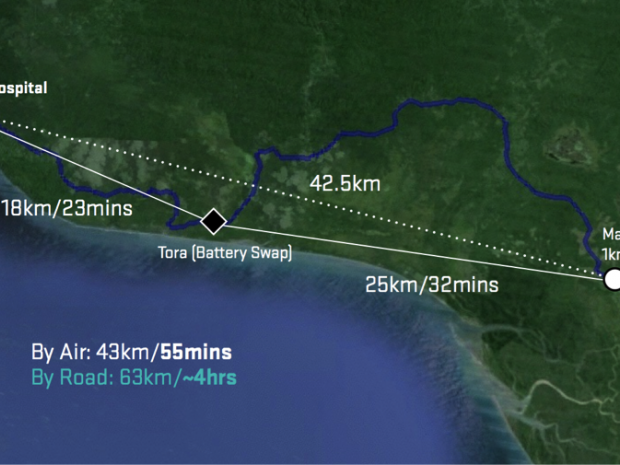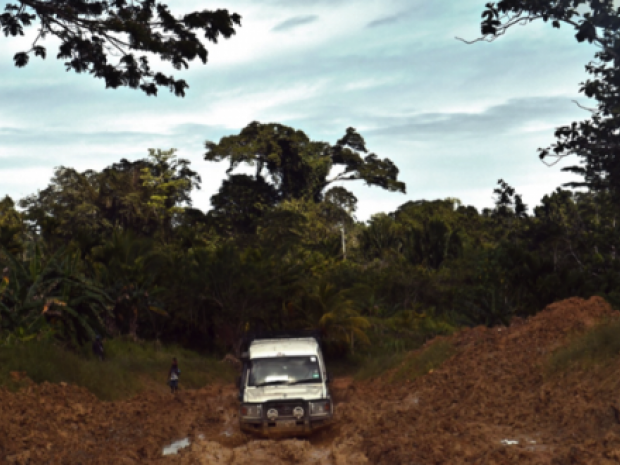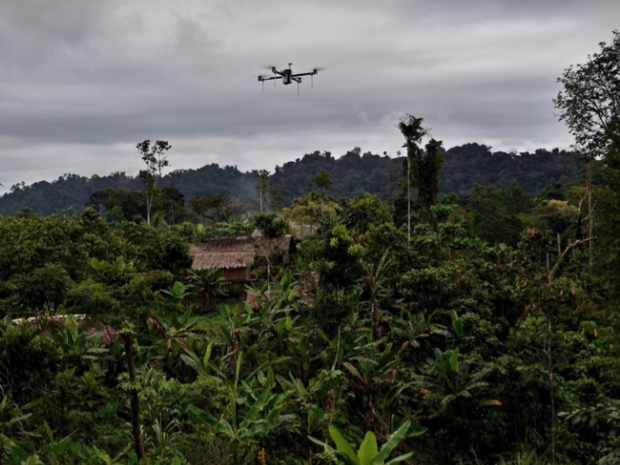Case Study No. 2: Delivery - Using Drones for Medical Payload Delivery in Papua New Guinea
Discussion details
EPIDEMIC | PROTRACTED CRISIS I DELIVERY
Type of system: Matternet One Prototype, Multicopter Microdrone
Deploying Agency: Médecins Sans Frontières (France)
Piloting Agency: Matternet
Dates of Deployment: September 2014
Summary
The limited access to healthcare diagnostics due to severe logistical constraints in Papua New Guinea has led Médecins Sans Frontières (MSF) to be one of the first humanitarian organizations to test the use of delivery drones. In 2014, technological challenges restricted the field use of this technology, but important lessons concerning acceptability and proof of concept are setting the stage for improvements in future missions.

Aerial transportation routes between Kerema hospital and Malalaua. Credit: Matternet.
Background
Access to healthcare in Papua New Guinea (PNG) is significantly limited by geographical and logistical challenges. This is particularly problematic given the high burden of tuberculosis (TB) in the country as well as an emerging epidemic of multi-drug resistant TB (MDR-TB). Poor data collection and reporting procedures along with inadequate infection control activities result in low case detection rates. Furthermore, diagnosis is mainly clinical and only available centrally as a result. There are also high costs for follow-up tracking due to logistical challenges and human resource constraints.
To Médecins Sans Frontières, the main problem was getting diagnostic samples from remote health centers to an MSF laboratory in the shortest amount of time. This led MSF to pilot the use of drones for payload delivery of diagnostic samples between remote health centers to Kerema hospital. The hospital has the only lab with functional microscopy and GeneXpert—the diagnostic tools necessary to analyze the samples. There are six health centres that range from 24 km to 137 km distant from the central hospital. Three of these centres are accessible only by boat while the other three are occasionally accessible via plane and walking. An onsite pilot project was carried out during the first two weeks in September 2014 in order to determine whether transporting the diagnostic samples via drones could result in faster analysis and treatment.
Implementation
Regulations and Local Engagement
The MSF Head of Mission managed the regulatory approval process, and the Civil Aviation Safety Authority (CASA) granted permission for the flights. There is only one flight per week in the area, and the local civil aviation authorities also approved the drone flights. According to MSF, both CASA and the Ministry of Health were very supportive of this project. MSF also engaged the local community in Karema to explain what drones were, how they were operated and why MSF was looking to use them in PNG. More specifically, MSF invited the local community to join them at the local football field in Kerema and made a demonstration of the technology. According to MSF, there were no objections from the local communities as everyone was supportive.
Technological Specifications
In terms of operations, MSF requested that all drone flights be autonomous, that the drone technology be reliable and sustainable and that the drones be easy to maintain and operate. Matternet had already tested their multi-rotor drone technology in Haiti in 2012. Their prototype battery-operated system could get a range of up to 28 kilometres and be operated autonomously. Currently, Matternet One—the first version of the Matternet drone—can fly autonomously, beyond visual line of sight, and carry 1 kilogram over 20 kilometres. Since Matternet One was not launched until 2015, Matternet brought six of the prototype drones for the Papua New Guinea project. The prototype is very similar to Matternet One with the main difference being that the prototype does not have the white frame used by Matternet One.

Some roads are barely accessible and at times completely unusable. Credit: Matternet
Site Selection and Flights
MSF selected Kerema hospital and a health clinic near Malalaua for the pilot project with Matternet. Matternet asked MSF to select take-off and landing locations that were clear of obstacles for the vertical take-off and landing of the prototype drone, and specified that the sites needed to be physically accessible; have cellular connectivity with General Packet Radio Services (GPRS) as a minimum; and have access to electricity—even if for just a few hours—to recharge batteries. Once MSF identified take-off and landing sites that met the criteria, Matternet simply used their software to generate the flight path between those two points.
Test flights were carried out between Kerema hospital and a health clinic near Malalaua—points selected in part because they were more accessible than other prospective sites. The total distance between these two points by road is 63 km, requiring a four-hour drive. By air, the distance is 43 km. Given the Matternet drone range of 28 km, the team decided to swap batteries at a village called Tora midway between Kerema hospital and Malalaua. The 55-minute travel time between the hospital and the clinic (including the time it takes to swap the batteries). According to Matternet, a total of 35 flights were carried out, 30 of which were fully autonomous.
A formal presentation made by MSF in June 2015, which is publicly available via YouTube,[1] notes that the project managed to make one very successful test between Kerema and the health center. The drone was flown with a 200-500 gram payload and was able to operate in winds of up to 36 km/hour. MSF reported “very good acceptance” of the technology by the local population and authorities. The MSF presentation notes that the acceptance was truly high, and cites the fact that of two of the Matternet drones lost in the jungle, one was retrieved by the local community and returned to MSF.
Evaluation

Inaccessible roads explain why MSF is exploring the use of drones. Credit: Matternet
MSF considered this pilot project to be just a trial of the technology, and did not carry out a comparative analysis of costs to determine whether payload delivery by drone would be less costly than by car. That said, MSF notes that the question of effectiveness goes beyond cost, and includes consideration of the time it takes to deliver the payload and the potential risks regarding not being able to access certain health clinics by road due to heavy rains. In this sense, the benefits that could be derived from using drones were most clearly visible in terms of delivery time (55 minutes versus four hours by car) and being able to avoid the risks of taking a car journey through difficult to access areas.
Any evaluation has to consider ease of use of the delivery mechanism. Matternet’s own evaluation of the project yielded a number of important lessons learned. The Matternet team highlighted the key importance of local knowledge and local skills as instrumental for the success of operating any drone project effectively. They also emphasized the importance of developing robust and reliable technology rather than using fancy gadgets coming out of Silicon Valley.
For MSF, the pilot project revealed that the maximum range of 28 km of Matternet’s drone was a notable constraint. The need for someone to swap batteries midway was subsequently considered by MSF to be an important disadvantage. At the time, the Matternet platform was still under development and thus not yet as mature as the Matternet One version. The constraint of 28 km was known by MSF before the project, but they still decided to proceed with the pilot as a learning opportunity and initial feasibility study. In conclusion, MSF believes that “the pilot project was worth it, but it needs further development to achieve reliable and regular operations.”
MSF continues to explore drone solutions to support their distribution efforts in PNG and beyond, and while their specific interests remain confidential, it is reasonable to assume that MSF is looking for a solution that will not require battery swapping. Such a requirement would most likely mean a drone that can fly long distances—a fixed-wing drone or hybrid drone, for example. What is known is that MSF was looking to carry out a second test either with Matternet or another company in 2015 but no such test took place.[1] MSF has also not made public where in Papua New Guinea it is looking to carry out the new tests.
Resources
https://www.youtube.com/watch?v=XpsGay6n8cM
http://f1000research.com/slides/1000069
Acronyms
| CASA | Civil Aviation Safety Authority |
| GPRS | General Packet Radio Services |
| MDR-TB | Multi-drug resistant TB |
| MSF | Medicins Sans Frontiers |
| PNG |
Papua New Guinea |
| TB |
Tuberculosis |
Author: Patrick Meier, Denise Soesilo, ed.
With special thanks to Oriol Lopez (MSF), Paola Santana (Matternet), Jo-Hannah Lavey and Otto Simonett (Zoi Environment Network) for their comments and suggestions.
[1] https://www.youtube.com/watch?v=XpsGay6n8cM

Drones in Humanitarian Action partially funded by DG ECHO. This case study covers humanitarian aid activities implemented with the financial assistance of the European Union. The views expressed herein should not be taken, in any way, to reflect the official opinion of the European Union, and the European Commission is not responsible for any use that may be made of the information it contains.

Log in with your EU Login account to post or comment on the platform.